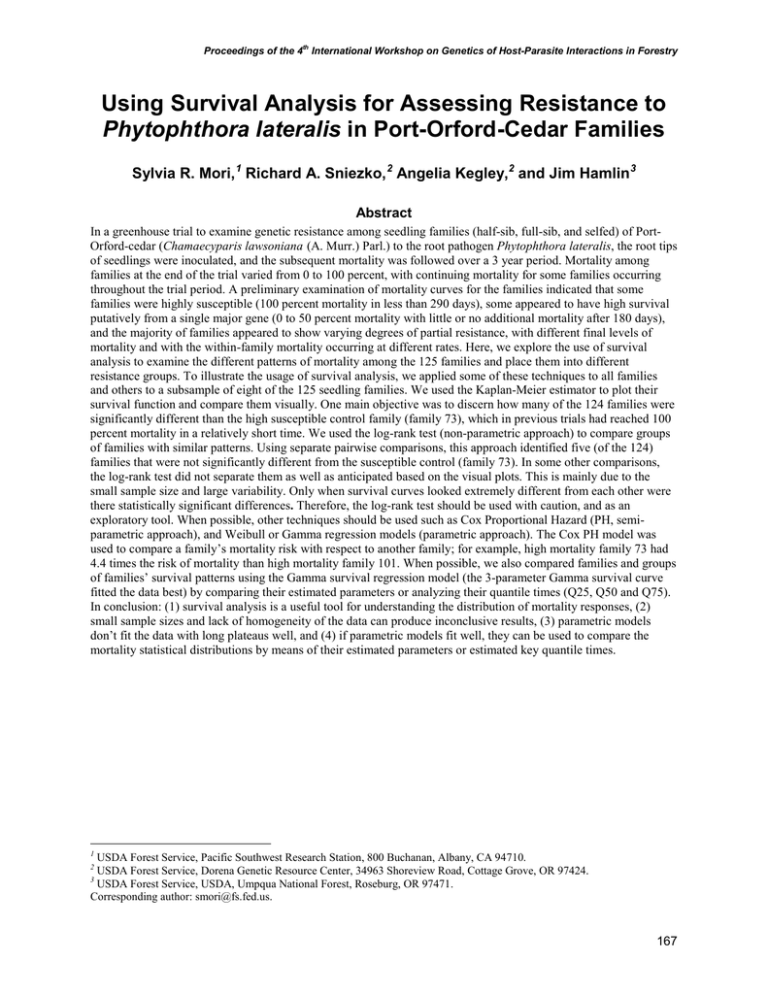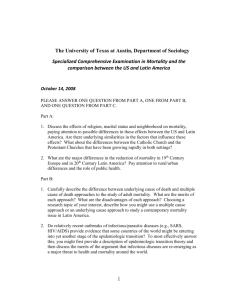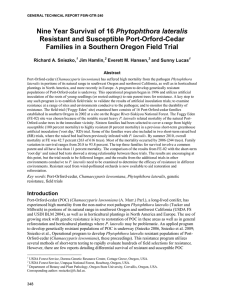Using Survival Analysis for Assessing Resistance to Phytophthora lateralis Sylvia R. Mori,
advertisement

Proceedings of the 4th International Workshop on Genetics of Host-Parasite Interactions in Forestry Using Survival Analysis for Assessing Resistance to Phytophthora lateralis in Port-Orford-Cedar Families Sylvia R. Mori, 1 Richard A. Sniezko, 2 Angelia Kegley,2 and Jim Hamlin3 Abstract In a greenhouse trial to examine genetic resistance among seedling families (half-sib, full-sib, and selfed) of PortOrford-cedar (Chamaecyparis lawsoniana (A. Murr.) Parl.) to the root pathogen Phytophthora lateralis, the root tips of seedlings were inoculated, and the subsequent mortality was followed over a 3 year period. Mortality among families at the end of the trial varied from 0 to 100 percent, with continuing mortality for some families occurring throughout the trial period. A preliminary examination of mortality curves for the families indicated that some families were highly susceptible (100 percent mortality in less than 290 days), some appeared to have high survival putatively from a single major gene (0 to 50 percent mortality with little or no additional mortality after 180 days), and the majority of families appeared to show varying degrees of partial resistance, with different final levels of mortality and with the within-family mortality occurring at different rates. Here, we explore the use of survival analysis to examine the different patterns of mortality among the 125 families and place them into different resistance groups. To illustrate the usage of survival analysis, we applied some of these techniques to all families and others to a subsample of eight of the 125 seedling families. We used the Kaplan-Meier estimator to plot their survival function and compare them visually. One main objective was to discern how many of the 124 families were significantly different than the high susceptible control family (family 73), which in previous trials had reached 100 percent mortality in a relatively short time. We used the log-rank test (non-parametric approach) to compare groups of families with similar patterns. Using separate pairwise comparisons, this approach identified five (of the 124) families that were not significantly different from the susceptible control (family 73). In some other comparisons, the log-rank test did not separate them as well as anticipated based on the visual plots. This is mainly due to the small sample size and large variability. Only when survival curves looked extremely different from each other were there statistically significant differences. Therefore, the log-rank test should be used with caution, and as an exploratory tool. When possible, other techniques should be used such as Cox Proportional Hazard (PH, semiparametric approach), and Weibull or Gamma regression models (parametric approach). The Cox PH model was used to compare a family’s mortality risk with respect to another family; for example, high mortality family 73 had 4.4 times the risk of mortality than high mortality family 101. When possible, we also compared families and groups of families’ survival patterns using the Gamma survival regression model (the 3-parameter Gamma survival curve fitted the data best) by comparing their estimated parameters or analyzing their quantile times (Q25, Q50 and Q75). In conclusion: (1) survival analysis is a useful tool for understanding the distribution of mortality responses, (2) small sample sizes and lack of homogeneity of the data can produce inconclusive results, (3) parametric models don’t fit the data with long plateaus well, and (4) if parametric models fit well, they can be used to compare the mortality statistical distributions by means of their estimated parameters or estimated key quantile times. 1 USDA Forest Service, Pacific Southwest Research Station, 800 Buchanan, Albany, CA 94710. USDA Forest Service, Dorena Genetic Resource Center, 34963 Shoreview Road, Cottage Grove, OR 97424. 3 USDA Forest Service, USDA, Umpqua National Forest, Roseburg, OR 97471. Corresponding author: smori@fs.fed.us. 2 167







